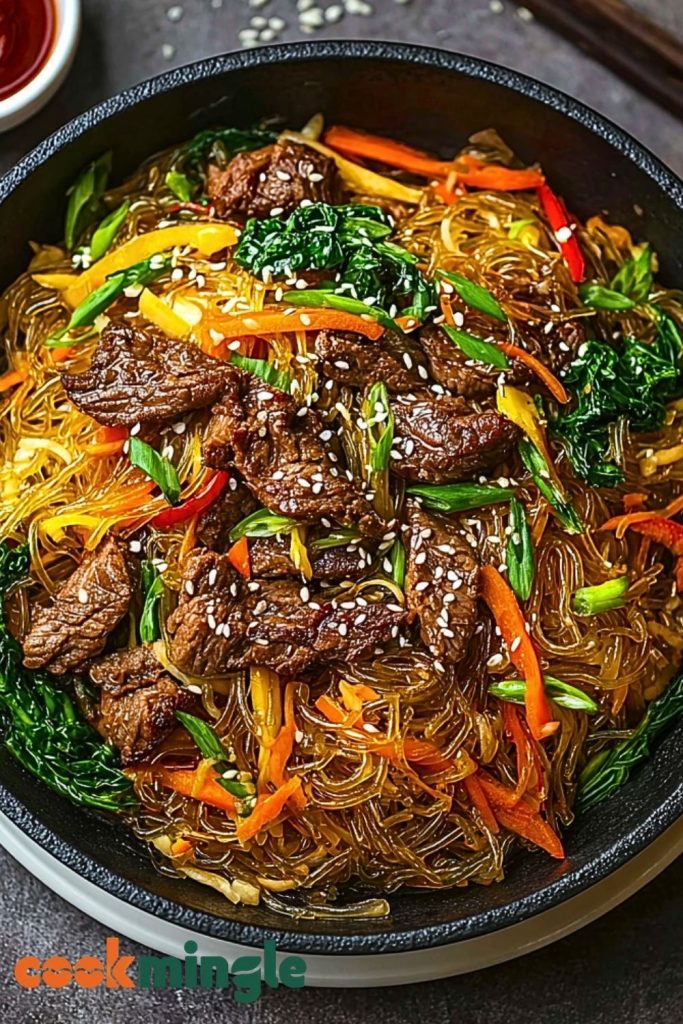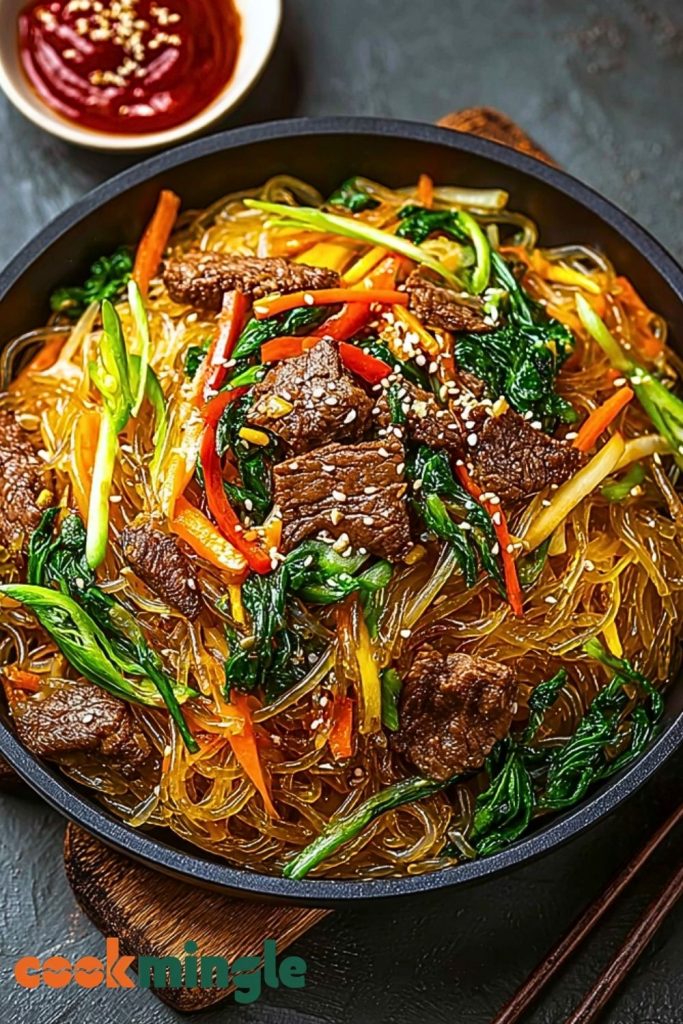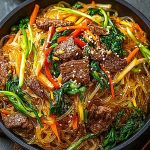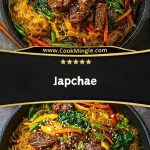There’s something magical about the first bite of Japchae. The chewy texture of glass noodles soaked in sweet-savory sauce, tender bites of marinated beef, and a colorful mix of sautéed vegetables come together like a celebration on a plate. I remember the first time I made Japchae at home—it felt like unlocking a secret dish usually reserved for special occasions or Korean restaurants. But once I realized how approachable it is with the right ingredients and steps, it quickly became one of my go-to meals for both gatherings and cozy nights in.

I love Japchae not just for its vibrant flavors but for its versatility. It can be served warm, at room temperature, or even cold. It works as a main dish or a hearty side. It’s naturally gluten-free if you use tamari instead of soy sauce, and it’s easily customizable. Whether you’re craving something meaty or want to keep it plant-based, Japchae has space for your personal twist.
Why You’ll Love This Japchae
Japchae is more than just noodles—it’s a full-on experience. You’ll love the harmony of textures: silky noodles, tender beef, crisp-tender veggies. The seasoning is a perfect balance of sweet and savory, without being overwhelming. It’s incredibly satisfying, light yet filling, and looks as beautiful as it tastes. Whether you’re cooking for yourself or impressing guests, this dish never fails to wow.
What Kind of Noodles Should I Use for Japchae?
For authentic Japchae, Korean sweet potato starch noodles—called dangmyeon—are essential. They’re translucent when cooked, with a pleasantly chewy, elastic texture that sets Japchae apart from other noodle dishes. These noodles soak up the sauce beautifully without getting soggy, making them perfect for this stir-fry.
You can typically find dangmyeon in Asian grocery stores or online. Avoid substituting them with rice noodles or vermicelli—those just won’t give you the same chewy, springy result.
Options for Substitutions
If you need to make some changes based on dietary needs or what’s in your pantry, Japchae is flexible enough to accommodate:
- No Beef? Swap it with chicken, shrimp, or tofu. Thin-sliced mushrooms like shiitake or oyster also make great plant-based alternatives.
- Gluten-Free? Use tamari or coconut aminos instead of regular soy sauce.
- Vegetables: Don’t have spinach or carrots? Use bell peppers, zucchini, or even napa cabbage. Just keep the colors vibrant and textures varied.
- No Sesame Oil? While sesame oil gives Japchae its signature aroma, a neutral oil with a sprinkle of toasted sesame seeds at the end can still work.
- Low Sugar? Reduce the amount of sugar or use a natural sweetener like honey or maple syrup.
Japchae welcomes adaptation while staying true to its bold and balanced character.
Ingredients for This Japchae
Each ingredient in Japchae plays a role in creating that iconic harmony of flavor, texture, and color. Here’s what you’ll need and why:
- Dangmyeon (Sweet Potato Glass Noodles): These are the star of the dish—glassy, chewy, and able to absorb sauce beautifully without becoming mushy.
- Beef (Ribeye or Sirloin): Thinly sliced, tender beef adds rich umami depth and protein. It’s marinated to soak up flavor before stir-frying.
- Carrots: Julienned carrots offer sweetness and a slight crunch, plus a vibrant orange pop.
- Spinach: Lightly blanched spinach adds freshness, earthiness, and a rich green color.
- Onion: Sliced onions caramelize slightly when stir-fried, bringing a soft sweetness to the mix.
- Green Onion: Adds sharpness and a fresh bite at the end for balance.
- Garlic: A must-have for its aromatic warmth that builds the flavor base.
- Soy Sauce: Brings saltiness and umami to the marinade and sauce.
- Sesame Oil: Essential for that nutty, toasted finish that defines Japchae.
- Sugar: A bit of sweetness balances the savory elements, creating that classic Korean flavor profile.
- Sesame Seeds: Sprinkled on top for texture and visual appeal.
Optional add-ins like mushrooms, bell peppers, or eggs can be layered in for even more complexity, but these core ingredients are all you need for an authentic Japchae experience.

Step 1: Prepare the Noodles
Start by boiling the sweet potato glass noodles according to the package instructions—usually around 6–7 minutes. Once cooked, drain and rinse them under cold water to stop the cooking. Cut them with scissors into shorter lengths (about 6 inches) for easier eating, then toss them with a drizzle of sesame oil to keep them from sticking.
Step 2: Marinate the Beef
In a small bowl, combine thinly sliced beef with soy sauce, sugar, minced garlic, and sesame oil. Let it marinate for at least 15 minutes while you prep the other ingredients. This step infuses the meat with flavor and helps it stay tender when cooked.
Step 3: Cook the Vegetables Separately
Heat a bit of oil in a pan and sauté the vegetables one at a time. Start with carrots, then onions, followed by spinach (which only needs a quick stir or blanching in boiling water for 30 seconds). Cooking them separately keeps their textures and colors distinct—important in Japchae’s final presentation.
Step 4: Stir-Fry the Beef
Using the same pan, cook the marinated beef over medium-high heat until browned and cooked through. This only takes a few minutes. Set aside with the vegetables.
Step 5: Combine and Season
In a large mixing bowl or wok, combine the noodles, cooked vegetables, and beef. Add soy sauce, a touch more sugar, garlic, and sesame oil to taste. Toss everything together gently over medium heat until heated through and evenly coated with the sauce.
Step 6: Garnish and Serve
Finish with a generous sprinkle of toasted sesame seeds and chopped green onions. Serve warm, at room temperature, or even chilled—it’s delicious any way.
How Long to Cook Japchae
From start to finish, Japchae takes about 35–40 minutes to make. Here’s the time breakdown:
- Noodles: 6–7 minutes to boil
- Beef Marination: 15 minutes (can overlap with other prep)
- Vegetable Stir-Fry: 10–12 minutes total, cooked separately
- Beef Cooking: 3–4 minutes
- Final Assembly & Stir-Fry: 5 minutes
It’s a bit of a process with separate steps, but each one is quick and simple. And the reward is absolutely worth it.
Tips for Perfect Japchae
- Prep everything first. Japchae moves fast once you start cooking, so have all your ingredients sliced, marinated, and ready to go.
- Cook each vegetable separately. This preserves their color, texture, and individual flavor instead of blending into one big stir-fry.
- Don’t skip the sesame oil at the end. That final drizzle adds a rich, nutty aroma that defines Japchae.
- Taste as you go. Adjust soy sauce, sugar, or sesame oil as needed for balance. Some prefer sweeter, others more savory—make it your own.
- Use a nonstick or well-seasoned pan. This helps prevent sticking, especially with glass noodles.
- Cut the noodles after boiling. Long noodles can be hard to manage in the pan or on a plate. Snipping them makes serving and eating easier.
With these tips, your Japchae will turn out glossy, flavorful, and beautifully balanced every time.
Watch Out for These Mistakes While Cooking
Even though Japchae is relatively simple, a few small missteps can affect the final result. Here’s what to avoid:
- Overcooking the noodles: Glass noodles should be chewy, not mushy. Stick to the package time and rinse with cold water right after boiling.
- Skipping the noodle oiling step: If you don’t toss the noodles with a little sesame oil after boiling, they’ll clump and stick together.
- Cooking everything together at once: Japchae shines because every component keeps its own flavor and texture. Stir-frying vegetables separately is key.
- Using too much soy sauce at once: It’s easy to over-salt. Add it gradually and taste along the way.
- Overcrowding the pan: This steams the ingredients instead of stir-frying. Cook in batches if needed.
- Skipping the garnish: Sesame seeds and scallions may seem optional, but they really round out the flavor and look of the dish.
What to Serve With Japchae?
Japchae is delicious on its own, but pairing it with the right side dishes or mains makes it even more satisfying. Try these:
Korean Mandu (Dumplings)
Pan-fried or steamed dumplings filled with pork, kimchi, or vegetables complement the soft chew of Japchae perfectly.
Kimchi
A spicy, tangy side like napa cabbage kimchi adds a sharp contrast to the slightly sweet flavors of the noodles.
Korean Fried Chicken
Crispy, saucy fried chicken is a bold, indulgent pairing that turns Japchae into a feast.
Gyeran Mari (Rolled Omelette)
This Korean-style egg roll is mild and fluffy, balancing out Japchae’s rich textures.
Steamed Rice
Though Japchae is already a noodle dish, steamed white rice makes a great neutral base if you’re serving it as a side.
Stir-Fried Mushrooms
Earthy mushrooms like shiitake or enoki sautéed in soy sauce and garlic echo the umami flavors in Japchae.
Korean Cucumber Salad (Oi Muchim)
This spicy, crunchy salad brings a refreshing, cooling contrast that cuts through the richness.
Doenjang Jjigae (Soybean Paste Stew)
A warm, comforting soup made with tofu, veggies, and fermented bean paste pairs wonderfully with the sweet-savory Japchae.
Storage Instructions
Japchae stores surprisingly well, making it a great option for meal prep or leftovers. Here’s how to keep it tasting fresh:
- Refrigerator: Store in an airtight container for up to 4 days. Let the noodles cool completely before sealing to prevent excess moisture.
- Freezer: Not ideal—freezing changes the texture of the noodles and vegetables. If you must freeze, do so in individual portions and reheat gently.
- Reheating: Warm in a nonstick skillet over medium heat with a splash of water or a drizzle of sesame oil. Microwave works too, but stir halfway through to keep the noodles from drying out.
The flavors often deepen by the next day, making leftovers even more delicious.
Estimated Nutrition
Please note these values are approximate and can vary depending on the exact ingredients and amounts used.
- Serving Size: 1 bowl (about 1½ cups)
- Calories: 350–400
- Protein: 15g
- Carbohydrates: 50g
- Sugar: 6g
- Fat: 12g
- Saturated Fat: 2g
- Fiber: 4g
- Cholesterol: 25mg
- Sodium: 600mg
Japchae is a well-balanced dish with protein, fiber, and healthy fats. To lighten it up, you can reduce the beef and oil or add more vegetables.
Frequently Asked Questions
What makes Japchae different from other noodle dishes?
Japchae uses dangmyeon, Korean sweet potato glass noodles, which have a uniquely chewy texture and glossy appearance. Combined with a sweet-savory sesame-soy sauce and stir-fried vegetables, it has a flavor and texture profile unlike any other noodle dish.
Can I make Japchae vegetarian or vegan?
Absolutely! Just omit the beef and add tofu or extra mushrooms for protein. Use a plant-based soy sauce and ensure your sugar is vegan (some refined sugars aren’t).
Is Japchae served hot or cold?
Both! Japchae is extremely versatile. You can enjoy it warm right off the stove, let it cool to room temperature, or even eat it chilled straight from the fridge.
Do I have to marinate the beef?
Yes, marinating the beef even for 15 minutes helps tenderize the meat and infuses it with flavor. It makes a big difference in taste and texture.
Can I prepare Japchae in advance?
Definitely. It actually tastes better after a few hours as the flavors meld. Just store it in the fridge and reheat gently when ready to serve.
What kind of beef should I use?
Use tender cuts like ribeye, sirloin, or flank steak. The key is slicing it thinly across the grain so it cooks quickly and stays tender.
How do I prevent the noodles from sticking?
Toss the noodles in a little sesame oil right after boiling and cutting. That keeps them separate and glossy until you’re ready to mix them with the other ingredients.
Is Japchae spicy?
Traditional Japchae is not spicy. However, you can add a kick by mixing in some gochugaru (Korean red pepper flakes) or a drizzle of gochujang (fermented chili paste) if you prefer heat.
Conclusion
Japchae is the kind of dish that checks all the boxes: comforting, colorful, healthy, and deeply satisfying. It’s rooted in Korean tradition but flexible enough to adapt to your pantry or dietary preferences. Whether you’re trying it for the first time or revisiting a beloved classic, Japchae is always a rewarding meal to prepare and share.
Once you’ve mastered the basics, you’ll find yourself coming back to this recipe again and again—it’s that good.

Japchae
- Total Time: 35 minutes
- Yield: 4 servings
Description
Japchae is a beloved Korean dish made with chewy glass noodles stir-fried with beef and colorful vegetables in a sweet-savory sesame soy sauce. This easy recipe is perfect for a quick dinner, meal prep, or an impressive addition to your party spread. Naturally gluten-free and endlessly customizable, Japchae delivers a healthy, satisfying meal that’s packed with flavor and texture. Whether you’re searching for dinner ideas, food ideas, or an easy recipe with a wow factor, this classic Korean noodle dish deserves a spot on your table.
Ingredients
200g Korean glass noodles (dangmyeon)
150g beef (ribeye or sirloin), thinly sliced
1 tablespoon soy sauce (for beef marinade)
1 teaspoon sugar (for beef marinade)
1 clove garlic, minced (for beef marinade)
1 teaspoon sesame oil (for beef marinade)
1 small carrot, julienned
1/2 onion, thinly sliced
60g spinach
1 green onion, chopped
2 cloves garlic, minced (for final seasoning)
2 tablespoons soy sauce (for seasoning)
1 tablespoon sugar (for seasoning)
2 teaspoons sesame oil (for seasoning)
1 tablespoon sesame seeds (for garnish)
1 tablespoon neutral oil (for stir-frying)
Instructions
1. Boil the glass noodles for 6–7 minutes until tender, then drain and rinse under cold water. Cut into 6-inch lengths and toss with a little sesame oil.
2. Marinate the thinly sliced beef in 1 tbsp soy sauce, 1 tsp sugar, 1 minced garlic clove, and 1 tsp sesame oil. Let sit for 15 minutes.
3. Heat a pan with a bit of oil and sauté the carrot for 2 minutes, then remove. Repeat separately with onions and spinach. Blanch spinach briefly and squeeze out excess moisture.
4. In the same pan, stir-fry the marinated beef until cooked through. Set aside with the vegetables.
5. In a large pan or wok, combine noodles, cooked beef, and vegetables. Add 2 tbsp soy sauce, 1 tbsp sugar, 2 minced garlic cloves, and 2 tsp sesame oil.
6. Toss gently over medium heat until everything is heated through and evenly coated.
7. Finish with chopped green onion and sesame seeds. Serve warm, at room temperature, or cold.
Notes
Cook each vegetable separately to keep the textures and colors distinct.
Toss the noodles with sesame oil after boiling to prevent sticking.
Japchae tastes even better the next day as flavors meld—perfect for leftovers!
- Prep Time: 20 minutes
- Cook Time: 15 minutes
- Category: Main Dish
- Method: Stir-Fry
- Cuisine: Korean
Nutrition
- Serving Size: 1½ cups
- Calories: 380
- Sugar: 6g
- Sodium: 600mg
- Fat: 12g
- Saturated Fat: 2g
- Unsaturated Fat: 8g
- Trans Fat: 0g
- Carbohydrates: 50g
- Fiber: 4g
- Protein: 15g
- Cholesterol: 25mg

